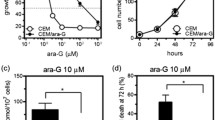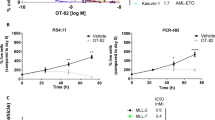Abstract
Purpose
4′-Thio-β-d-arabinofuranosylcytosine (4′-thio-ara-C), which has shown significant cytotoxicity against a panel of human tumor lines, was evaluated for antitumor activity against a spectrum of human tumor systems in mice.
Methods
Antitumor activity was evaluated in 15 subcutaneously implanted human tumor xenografts. 4′-Thio-ara-C was administered intraperitoneally using either q1d×9 (daily treatment for nine consecutive days) or q4h×3/q1d×9 (three treatments each day separated by 4-h intervals for nine consecutive days).
Results
4′-Thio-ara-C exhibited an excellent spectrum of activity. Treatment with the compound was curative against HCT-116 colon, SW-620 colon, NCI-H23 NSCL, and CAKI-1 renal tumors and resulted in partial/complete regressions in the DLD-1 colon, NCI-H522 NSCL, DU-145 prostate, and PANC-1 pancreatic tumor models. Tumor stasis was noted for HT29 colon and NCI-H460 NSCL tumors. Tumor inhibition was observed for A549 NSCL, PC-3 prostate, LNCAP prostate, and MDA-MB-435 breast tumors. Of the 15 tumors examined, only CFPAC-1 pancreatic was unresponsive to the compound. In contrast, 1-β-d-arabinofuranosylcytosine was minimally active at best against CAKI-1 renal, HCT-116 colon, NCI-H460 NSCL, and SW-620 colon tumors. Schedule- and route-dependency studies were conducted using the NCI-H460 NSCL tumor. The activity of 4′-thio-ara-C was independent of schedule when comparing q2d×5 (every other day for five treatments), q1d×9, and q4h×3/q1d×9 treatment schedules. 4′-Thio-ara-C was equally effective by the intravenous and intraperitoneal routes of administration, with the oral route being less efficacious.
Conclusions
On the basis of these results, 4′-thio-ara-C appears to have a profile distinct from other nucleoside antitumor agents and is being advanced to clinical trials.


Similar content being viewed by others
References
Anonymous (2000) Drugs of choice for cancer chemotherapy. Med Lett 42:83
Braakhuis BJM, Ruiz van Haperen VWT, Boven E, Veerman G, Peters GJ (1995) Schedule-dependent antitumor effect of gemcitabine in in vivo model systems. Semin Oncol 22:42
FDA (2003) List of approved oncology drugs with approved indications. http://www.fda.gov/cder/cancer/druglistframe.htm
Gish DT, Kelly RC, Camiener GW, Wechter WJ (1971) Nucleic acids. 11. Synthesis of 5′-esters of 1-β-d-arabinofuranosylcytosine possessing antileukemic and immunosuppressive activity. J Med Chem 14:1159
Hertel LW, Kroin JS, Grossman CS, Grindey GB, Dorr AF, Storniolo AMV, Plunkett W, Gandhi V, Huang P (1996) Synthesis and biological activity of 2′,2′-difluorodeoxycytidine (gemcitabine). In: Ojima I, McCarthy JR, Welch JT (eds) Biomedical frontiers of fluorine chemistry. American Chemical Society, Washington, DC, p 265
Ototani N, Whistler RL (1974) Preparation and antitumor activity of 4-thio-analogues of 2,2′-anhydro-1-β-d-arabinofuranosylcytosine. J Med Chem 17:535
Parker WB, Shaddix SC, Rose LM, Waud WR, Shewach DS, Tiwari KN, Secrist JA III (2000) Metabolism of 4′-thio-β-d-arabinofuranosylcytosine in CEM cells. Biochem Pharmacol 60:1925
Skipper HE, Schabel FM Jr, Wilcox WS (1967) Experimental evaluation of potential anticancer agents. XXI. Scheduling of arabinosylcytosine to take advantage of its S-phase specificity against leukemia cells. Cancer Chemother Rep 51:125
Tiwari KN, Shortnacy-Fowler AT, Cappellacci L, Parker WB, Waud WR, Montgomery JA, Secrist JA III (2000) Synthesis of 4′-thio-β-d-arabinofuranosylcytosine (4′-thio-ara-C) and comparison of its anticancer activity with that of ara-C. Nucleosides Nucleotides Nucleic Acids 19:329
Waud WR, Gilbert KS, Shepherd RV, Harwell JE, Tiwari KN, Secrist JA III, Montgomery JA (1999) Preclinical antitumor activity of 4′-thio-β-d-arabinofuranosylcytosine (4′-thio-ara-C). Proc Am Assoc Cancer Res 40:297
Whistler RL, Doner LW, Nayak UG (1971) 4-Thio-d-arabinofuranosylpyrimidine nucleosides. J Org Chem 36:108
Acknowledgements
This work was supported by NCI grant PO1-CA34200. The authors gratefully acknowledge the technical assistance of the staff of the Cancer Therapeutics and Immunology Department. J. Tubbs and G. Jones assisted with data management, and K. Cornelius prepared the manuscript.
Author information
Authors and Affiliations
Corresponding author
Rights and permissions
About this article
Cite this article
Waud, W.R., Gilbert, K.S., Shepherd, R.V. et al. Preclinical antitumor activity of 4′-thio-β-d-arabinofuranosylcytosine (4′-thio-ara-C). Cancer Chemother Pharmacol 51, 422–426 (2003). https://doi.org/10.1007/s00280-003-0589-9
Received:
Accepted:
Published:
Issue Date:
DOI: https://doi.org/10.1007/s00280-003-0589-9




